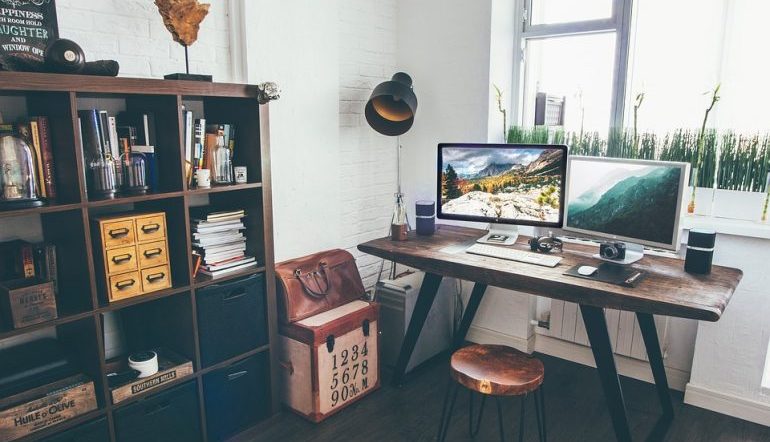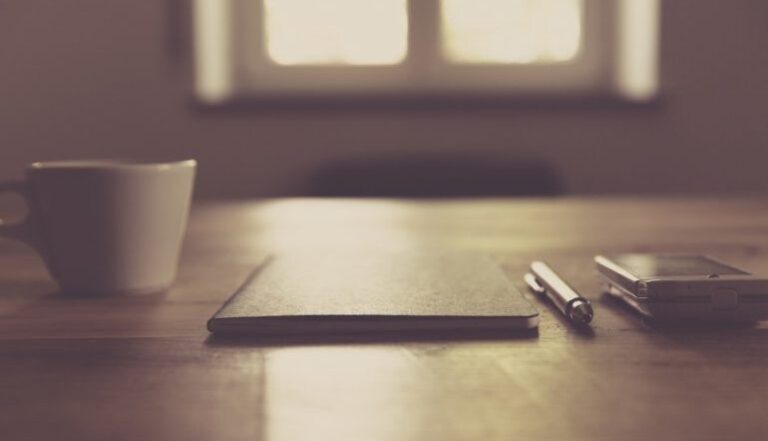
Guest post by Aimee Nezhukumatathil
This is the first year since I started teaching at SUNY-Fredonia–nine years ago now–that I didn’t leave my house to go on a writing retreat (awarded or self-imposed). I have an office at home painted my favorite shade of robin’s-egg blue with red accents and it houses almost all of my poetry and non-fiction books in one space. In winters, it’s the warmest room in the house, as it is right above the furnace, and in summers, all I need is to crack open the windows for a bit of breezy peony perfume. Pine trees shade this side of the house so even on the few truly hot days of Western NY where even strawberries seem to melt into the ground, not even a box fan is needed–there’s always the faintest of breeze, enough to have me still use the almost-all-but-extinct paperweight on my desk when I work.
During the school year, I know I won’t want to be too far away from my infant child when I do write, so my husband and I have lined up two stellar former students to come over and give us the gift of two to three hours a day where we can hole up away in our respective offices while we scratch out a few lines or pages of a story. Just knowing I could walk down the hall if I need to (or if my baby needs me) is all the assurance and confidence I need to balance those heady first months with a newborn.
Since we already had a room designated and decorated as a nursery from my elder son, I spent much of my pregnancy putting together my “room of one’s own”–especially since I found out I will be the only woman in a house of boys and a man. It was important for me to have a space I could call mine and close the door if and when I need to, but also to have it as an open space where my boys could wander in and find drawerfuls of paper and markers (and M&Ms if they are lucky!) and browse the bookshelves I have full of writers of all colors and genders.
I want them to have a space where they could eventually retreat to and get lost. As Virginia Woolf notes in
her famous essay, “Life for both sexes–and I look at them, shouldering their way along the pavement–is arduous, difficult, a perpetual struggle. It calls for gigantic courage and strength. More than anything, perhaps, creatures of illusion that we are, it calls for confidence in oneself.”
My favorite space to write has a glass-topped table with my Grandfather’s old typewriter that still works. It’s the very typewriter that he used to write pithy but meticulous observations about life in his small town in India to his American granddaughter since she was just five years old and never stopped until his death when I was a junior in high school.
How I loved to spy the blue and red envelopes or thin blue
aerogrammes in the day’s stack of mail–I knew there would be a whole world of pineapple thieves and cobra catchers detailed and waiting just for me inside. I write longhand in a spiral journal first, then transfer it to my iMac days or weeks later, after I have had time to tumble those words around a bit longer in my head. There’s a postcard of Marion MacDowell (of the famed and much-appreciated
MacDowell Colony that has given me a beautiful workspace in the New Hampshire woods twice now) “watching over me,” as my friend put it, as if she is also helping to protect my space. Also of note is a picture of one of the
whale sharks I swam with during my sabbatical in Atlanta, a shadowy force to be reckoned with.
I often laugh with my parents when we wonder how on earth I ever became a writer–we did go to libraries often, there was no limit on how many times my tired and exhausted parents would drive us there, even after a twelve-or-more-hour shift at the hospital–but there was hardly any paper in the house. The “literature” left on bookshelves low enough for my sister and me to reach and read consisted of various Physician’s Desk References or such dazzlingly intriguing titles such as Visual Manuel of Skin Diseases, Diagnostic and Statistical Manual of Mental Disorders, or The Pill Book. And sometimes, if we were lucky, my dad would bring home some Reader’s Digests or the occasional outdated and waxy National Geographic for us girls.
Buying school supplies each year filled me both with glee and a bit of dread. Even though my mom was a doctor and we could certainly afford it, she never let us get name-brand school supplies. Oh, how I envied the kids who had Crayola crayons, especially the ones with the built-in sharpener. Sixty-four colors, including metallic shades of silver and gold! Using my off-brand crayons was just about like one step up from writing with candles. I didn’t have
glue, I had those little containers of
paste with a built-in stick “spreader” that usually dried out by October. When we had craft projects at school or wrote and illustrated our own stories and poems and our teacher let us have basically free-range over the beloved art-supply cabinet, I clearly remember being one of the last to finish up, secretly lingering over each word, carefully printed out in marker in the best handwriting I could manage. Each word was deliberate, accounted for. Oh how I hated the school bell when it signaled it was time to clean up.
On second thought, maybe that is exactly how I became a writer.
So, Dear Readers, it got me thinking: What is your favorite space to create? Do you have a special object or three that you must have nearby to write? Or are you one of those people who can write anywhere–loud/quiet, music on/off, people around you or not, as long as you have a notebook and a pen? I asked some writer-pals this question, and here’s what they had to say:
The half-dead plant on my window sill is
not my favorite thing in my writing space but is a literal manifestation of how I cannot possibly tend to all the things “on my desk” or in my life. My favorite things in my study are a scrap of paper my friend
D. A. Powell bought for me at an auction that says, in
James Schuyler‘s handwriting, “Sorry, but I don’t have favorite lines in my own verse–” and a photograph of my husband and me wearing life jackets, standing on a glacier in Churchill, Canada (on our 40 days cross-country honeymoon).
The photo with red curtains is a former writing space. This is where I wrote my latest book, Ordinary Genius, A Guide for the Poet Within. My Magic 8 Ball was never far away and was handy for consultations: “Should I cut this chapter?” REPLY HAZY, TRY AGAIN. “Is my editor avoiding me?” BETTER NOT TELL YOU NOW. Now I write mostly in bed, where I feel furthest from the normal world and so most able to engage in the abnormal activity of creative writing. The item I most like to keep handy is my cat, Edna St. Vincent Millay.
This is what you do when your kids grow up: You take pictures of your cat.
I’d like to say I resisted the mighty urge to straighten my desk, but there was none: a pristine desk is a chilly place to me. And so this is all my clutter, in situ. I wish you could see at the picture’s right edge the carriage of an ancient Royal typewriter, a gift from my father when I first left home for graduate school.
Above my writing desk hangs a vintage metal sign. TO LIFE BOATS it reads, with an urgent arrow pointing to the right ==> As a writer’s totem, the sign is both amusing and instructive. On summer days when writing at my desk does not go well, I obey its directive: I walk outside with my pages of poems to the pond, and I sit on the dock, which leans precariously into the water.
There the breeze kicks away the mind’s fog. I feed bits of bread to the koi. I like to watch the fish circulate in the water. They have nothing to do with poetry, and this fact somehow allows me to write again.
I’m fortunate enough to have a room of my own in which to write and think and look out the window.
My desk is tucked into a corner with a gray four-drawer file cabinet between two windows, one of which faces my backyard and a mimosa tree and the other of which faces my neighbor’s obscenely fertile garden. The writing space itself is crowded with work from all my lives: poem drafts, dissertation research, editorial files, friends’ manuscripts, bills, recipes, and a receipt from a recent restaurant splurge. Amidst the work, though, I surround myself with photos of friends and family and favorite postcards I’ve received over the years.
My favorite photo is framed, sitting by my lamp next to my red lipstick and two desiccated radishes leftover from last week’s lunch (a reinterpretation of Hemingway’s apples?). I don’t know the figures in this photo, but I know and love their spirit. They are musicians playing on a boat; they are mid-performance; I can see the boat’s wooden floorboards, a sliver of the rollicking sea. Whenever I’m overwhelmed by work–all I have to do every day every week–I look at this photo and I remember that, as it is for the musicians, good hard work is ultimately play.
These days I write and read on my bed.
I place my laptop by the headboard and sit cross-legged before it. There’s always a small stack of books and DVDs close by because I like to take a lot of breaks when I’m working on new poems or revising my manuscript.
I have various unofficial writing mascots (a painting of chickens, a fox picture by my friend
Elizabeth Zechel).
This picture of “Kangamouse,” a little pink creature that washed up onshore at Dead Horse Bay and was photographed by Adrian Kinloch, has been living next to my computer for about nine months. I was supposed to write a poem about him for
Underwater New York (and I eventually did), but I think he’s a poem all by himself.
This is Aimee’s second post for Get Behind the Plough.
Images courtesy of the authors.



